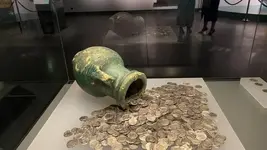Hook111111
Jr. Member
- Joined
- Oct 5, 2020
- Messages
- 31
- Reaction score
- 56
- Golden Thread
- 0
- Detector(s) used
- Garret atx
- Primary Interest:
- All Treasure Hunting
- #1
Thread Owner

The archaeological treasure of Sinaw was discovered in the Sultanate of Oman, where the largest treasures of gold coins that were found in the Sultanate of Oman were discovered and is the largest so far, and it was found lying inside a pottery vessel since Shawwal from 1399 AH - September 1979 AD, and it was found in Sinaw Prosecutor in the state of Al-Mudhaibi from the North Sharqiya Governorate.
The history of the Sinaw treasure discovered in Oman from a huge collection of coins
The earthenware vessel filled with ancient gold coin hoard dates back
It is a glazed vessel in a beautiful turquoise blue color
And it has handles on the sides that are aesthetically pleasing
It contained the (962) pieces of silver dirhams inside
This great treasure can be traced back to the Sasanian eras and the early early Islamic civilization
The oldest dirham of this treasure goes back to the rule of Hormuz IV: who is it?
The oldest of these coins, a dirham, was found inside the pottery from the period of the reign of King Hormuz IV - which is Khosra II
Which was between (589 AD - 623 AD)
Meaning that it dates back more than 1,400 years ago
However, the last dirham found in treasure dates back to the reign of the Abbasid Caliph Al-Mu'tasim Billah (226 AH - 840-841 AD).
The coins that were found in that treasure were minted within the various ancient Islamic civilizations, such as:
Minted in Spain (ancient Andalusia)
And it was minted in North Africa (the ancient Abbasid state)
And in Egypt
And in Syria (Damascus in the past)
And in Iraq
And in the South Caucasus
It was also minted in the Arabian Peninsula
And in Iran
And was silenced in the countries beyond the river (now called Asia Minor)
All civilizations were brought from these coins and minted in these areas in the past, and all coins were collected in the pottery vessel now
This gives an overview of the great and effective role played by the Sultanate of Oman in the past.
Exactly these two famous Islamic covenants, namely the Umayyad and Abbasid covenants



